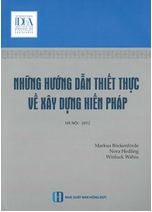Những hướng dẫn thiết thực về xây dựng hiến pháp, International IDEA - 2013
The content of a constitution (in Vietnamese) provides a blueprint for the operation of a state, guarantees rights and outlines mechanisms for their enforcement, as well as shapes the future of a nation. Constitutions that emerge after conflict are often a result of negotiated settlements and competition between many forces including identity-based groups, former parties to conflict, political and military actors and international actors.
A Practical Guide to Constitution Building provides an essential foundation for understanding constitutions and constitution building. Full of world examples of ground-breaking agreements and innovative provisions adopted during processes of constitutional change, the Guide offers a wide range of examples of how constitutions develop and how their development can establish and entrench democratic values. Beyond comparative examples, the Guide contains in-depth analysis of key components of constitutions and the forces of change that shape them.
The Guide analyzes the adoption of the substantive elements of a new constitution by looking at forces for the aggregation or dissemination of governmental power, and forces for greater legalization or politicization of governmental power, and examining how these forces influence the content of the constitution. It urges practitioners to look carefully at the forces at play within their individual contexts in order to better understand constitutional dynamics and play a role in shaping a constitution that will put into place a functioning democratic government and foster lasting peace.
To access the Guide, please click the following link:
http://www.idea.int/publications/pgcb/vi.cfm
